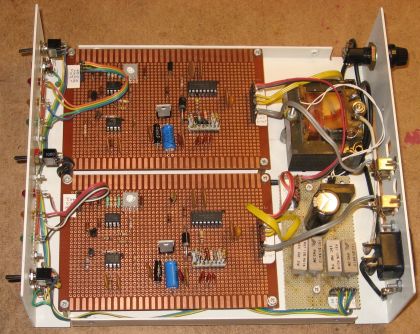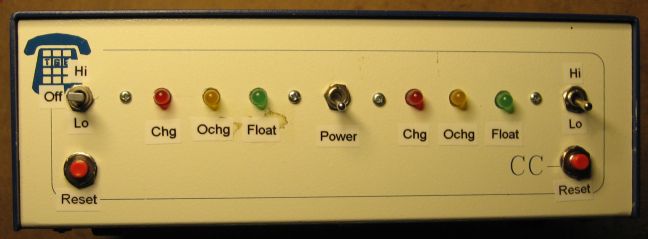UC3906 Gel-Cell Battery Charger
I've collected a few gel-cell
batteries over the
years and seen some die for no apparent reason. Finally I found out
why: lead-acid type batteries need to be float charged continuously
(around 13.8V for a 12 volt battery) to keep them from deteriorating.
Research showed that an ideal charger has 3 modes: bulk charge,
overcharge, and float charge. I searched for a good charger that could
be built easily and do all that. Eventually I found a project by VK3EM
which didn't look too complicated, based on the UC3906
chip, which is available from DigiKey for around C$7.
The original geocities link to the VK3EM project no
longer
works, but I saved a copy (PDF document) and you can download it from here.
It contains all the construction details and circuit diagrams.
I built 2 chargers for small SLA batteries, in one box sharing one power
supply:


I used an old modem box for the project, thus the telephone
graphic on the front panel. Chg = charging, Ochg = overcharge mode,
Float = fully charged.
You should go over the calculations for 6 of the resistors
that control the UC3906 as per the spec sheet. (Perhaps your
battery requires a different float charge voltage.) After tediously doing this
a few times I finally wrote
this program to
make it easier. I placed my resistors on a small solder header so I can
change them more easily if required.
Update - if you're looking for some nice UC3906 based kits, check out A & A
Engineering. Update: alas the 1A and 5A chargers have been discontinued. But the site still has quite a bit of useful information.
Update
- I have been using these chargers for several years and found a few
shortcomings. Firstly, two UC3906 chips have inexplicably failed. The
result is the battery goes off charge. There is no indication from the
status LEDs, the green LED remains on as if everything was OK. The only
way to know is to test the battery voltage and see that it is not 13.8 as it
should be. Replacing the UC3906 restores proper operation. There is no
apparent reason for the failure that I could see.
Secondly, I
had been using one large battery for a long time, more than 10 years. I
credit the charger for keeping the battery in good shape for so long.
Finally one cell shorted out. Again, the green LED remained on, with no
indication of any problem. This time I detected the problem when I
touched the battery and found it was warm. The voltage was 10.9 and
would not go higher.
These problems show a need for monitoring
the battery voltage and sounding an alarm if a problem is detected. The
charger needs an "fault" LED. Then if the green LED is on and the
battery voltage is low, turn on the fault LED. I will look in to this
as time permits. Please check out my latest charger which has an ATtiny861 monitor.
Back
to VE3LNY's Other Projects Page



